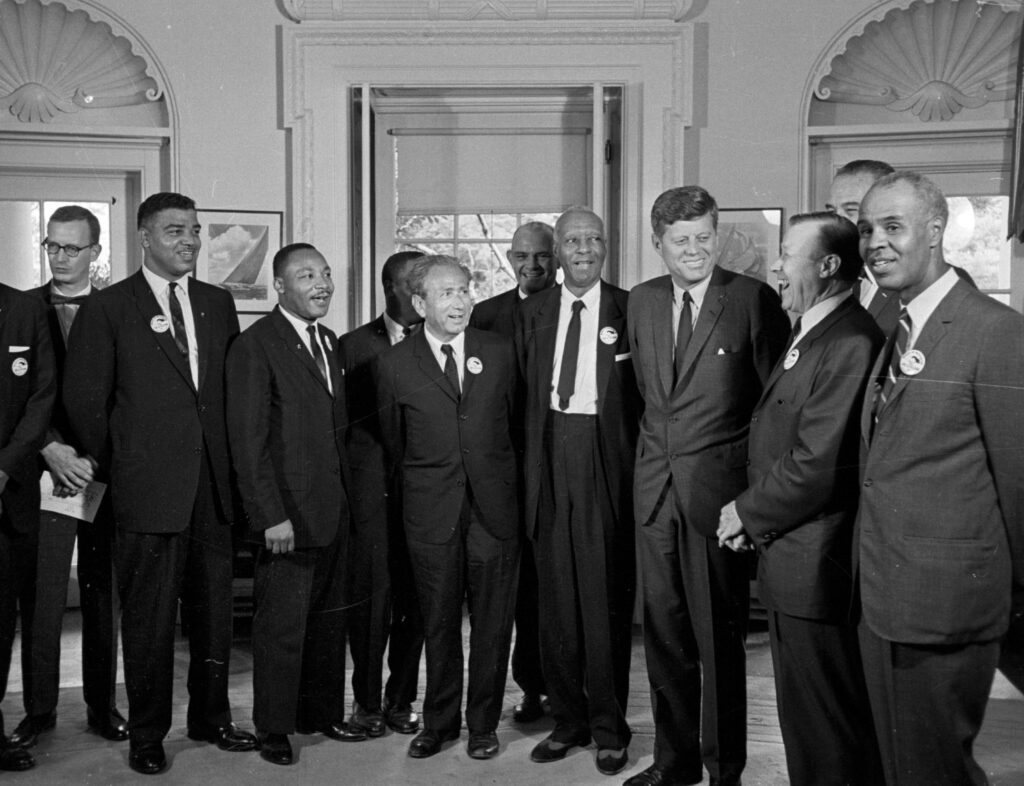Rebuilding a nation torn apart by political divisiveness requires information we can trust. It requires an honest policy-making process.
Historically — protesters petitioned for better policies.
In the 1960’s, civil rights protests resulted in civil rights policies. That occurred because the president met with protest leaders to talk policy. That in turn pushed Congress to act. The American political process worked.

Then as now, it took brutal treatment of Americans put on display —for all the world to see— before leaders felt moved to take action.

SOURCE: Daily News
“From May 2 to May 10, 1963, the nation bore witness as police in Birmingham, Ala., aimed high-powered hoses and sicced snarling dogs on black men, women and even children who wanted just one thing — to be treated the same as white Americans.”
It was not a single act that brought the Civil Rights Movement to this point, it was decades of struggles. But it isn’t over. The struggle persists to “Let America Be America Again—The land that never has been yet— “.
By no means have we reached our destination.
The Ask
Then and now, “the ask” is the same. Protect everyone’s constitutional rights under federal laws “such as the rights to be free from excessive force; unreasonable stops and searches; arrests without warrants or sufficient cause, or in retaliation for exercising free speech; and discrimination based on factors such as race, ethnicity, national origin, religion, disability, and sex—including sexual orientation, gender identity, and LGBTQ status” (Crime Rates Decline After Police Reforms). Treat Americans as Americans.
What does this have to do with supporting public education? Everything
If we can’t see people on the streets as equals, children in classrooms will suffer the same fate.
Our public schools mirror what is happening within our society. That is an undeniable fact. Consequently, real and lasting improvements to public education require a constructive political process capable of taking this nation from protests to policies that work for all Americans.
Looking through the lens of equality and fairness — if lawmakers aren’t willing to pass laws that benefit this nation’s everyday citizens, then we need to change those lawmakers — repeatedly. But in addition, what history tells us is this; We have to speak loudly, clearly, repeatedly, and in large numbers leaving no question as to what We need. Leave no room for excuses for not working for us, right now.
“The time is always right to do what is right.”
So, how do we decide what is “the right” thing —the best thing— to do right now?
If the politics of 2020 taught us nothing else, it demonstrated the destructive nature of bad and misleading information. But in reality, we already knew that. Decades ago, policymakers recognized the nation’s need for reliable research and the development of practical solutions based on trustworthy information.
Therefore, the first step in rebuilding is the dissemination of knowledge we can trust.
Rebuilding Requires Trustworthy Research and Development
From President Washington to Lincoln to Kennedy to Reagan, we have had presidents that acknowledged the importance of “institutions for the general diffusion of knowledge.” And this is the story of How Our Great Public Education Institution Was Created.
“… Abraham Lincoln demonstrated presidential leadership in signing the Morrill Act. It promoted “the liberal and practical education of the industrial classes in several pursuits and professions of life.” This set the foundation for the land-grant college system, our agricultural experiment stations, and extension (diffusion) of practical research-based information.”
Based on the success of over 100 years of experience, the educational visionaries of the Kennedy administration wrote that same concept into education law – the 1965 Elementary and Secondary Education Act (ESEA).
“Regional educational laboratories were developed for the basic research and development of practical solutions to the issues facing schools. They would serve as a the bedrock of excellence promoting use of best practices. The information provided was then to be disseminated (diffused) to the schools. But a network to freely disseminate information and assist in training at the local level was never fully realized.
Rebuilding Better than Before Requires Knowing What Cracked Our Strong Educational Foundation
Now — with the hindsight of 2020 vision — documents show that by the mid-80’s, business leaders began seeing public education as an industry to conquer and pillage. But at the time, public education was making huge gains in student achievement as well as making monumental leaps towards equal access. Therefore educational progress needed to be disrupted to create market demand for educational products.
The Overthrow of the Public Education System Began by Targeting Research & Dissemination of Information
By the late 80’s, it was noted that “economic and political dynamics” left the regional educational laboratories’ system struggling. But strategies for systemic improvement didn’t surface. Instead, our system adopted “entrepreneurial strategies” … “not always consistent with the initially conceived mission as knowledge brokers serving local districts.”
In other words, the knowledge foundation for real education reforms cracked under the pressure to adopt the Market Based -fake- Reforms serving the education industry.